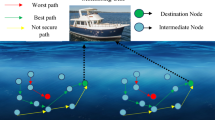Abstract
In underwater acoustic sensor networks (UASN), the main challenging issues are bandwidth, higher propagation delay, and heavy packet loss during data transmission. The issues can be solved through efficient routing algorithms. Due to the complexity and variability of the underwater acoustic environment, the underwater acoustic sensor network has the characteristics of fluidity, sparse deployment, and energy limitation, which brings certain challenges to underwater positioning technology. Aiming at the scenario that the node redundancy in the underwater acoustic sensor network leads to low positioning efficiency, this paper has proposed the deep learning-high dynamic biased track (DL-HDBT) algorithm. The DL-HDBT combines the deep learning and hybrid dynamic biased tracking algorithm. Deep learning (DL) helps in the identification of the best relay nodes in the network and traffic-congested nodes are tracked using a high dynamic bias track. The routing protocol has been implemented in the ns2-AqaSim simulator and testbed for measurement of the performance metrics of the UASN. The simulation results showed that the novel routing method throughput has increased by 17%, 35%, and 57% when compared with SUN, VBF and DF method. It can effectively improve the throughput of nodes, balance positioning performance as well as energy use efficiency, and optimize the positioning result of UWASN.













Similar content being viewed by others
References
Akyildiz F, Pompili D, Melodia T (2005) Underwater acoustic sensor networks: research challenges. Ad Hoc Netw 3:257–279
Anuradha D, Srivatsa SK (2019) Energy effectual reconfigurable routing protocol (E2R2P) for cluster based underwater wireless sensor networks. J Ambient Intell Humaniz Comput 6:453–461
Arifur Rahman MD, Lee YD et al (2017) EECOR: an energy-efficient cooperative opportunistic routing protocol for underwater acoustic sensor networks. IEEE Access 5(2):14119–14132
Ayyadurai M, Selvakumar Raja S (2020) Optimisation of data reliability in UASN using adaptive Buffalo algorithm. J Ambient Intell Humaniz Comput
Chen Y, Jin X et al (2018) Selective dynamic coded cooperative communications for multi-hop underwater acoustic sensor networks. IEEE Access 7:70552–70563
Diamant R, Lampe L, Gamroth E (2017) Bounds for low probability of detection for underwater acoustic communication. IEEE J OE 42(1):143–155
Diamant R, Casari P et al (2018) Fair and throughput-optimal routing in multimodal underwater networks. IEEE Trans Wirel Commun 17(3):1738–1754
Gong Z, Li C et al (2018) AUV-aided joint localization and time synchronization for underwater acoustic sensor networks. IEEE Signal Process Lett 25(4):477–481
Goyal N, Dave M et al (2015) Fuzzy based clustering and aggregation technique for under water wireless sensor networks. ICECS, pp 1–4
Hu T, Fei Y (2010) QELAR: a machine-learning-based adaptive routing protocol for energy-efficient and lifetime-extended underwater sensor networks. IEEE Trans Mob Comput 9(6):796–809
Jouhari M, Ibrahimi K et al (2019) Underwater wireless sensor networks: a survey on enabling technologies, localization protocols, and internet of underwater things. IEEE Access 7:96879–96899
Khan A, Ali I et al (2018) Co EEORS: cooperative energy efficient optimal relay selection protocol for underwater wireless sensor networks. IEEE Access 99(1):1–15
Lee YM (2017) Classification of node degree based on deep learning and routing method applied for virtual route assignment. Ad Hoc Netw 58(4):70–85
Li X, Sun Y, Guo Y, Fu X, Pan M (2017) Dolphins first: Dolphin-aware communications in multi-hop underwater cognitive acoustic networks. IEEE Trans Wirel Commun 16(4):2043–2056
Qiuli C, Wei X, Fei D, Ming H (2018) A reliable routing protocol against hotspots and burst for UASN-based fog systems. J Ambient Intell Humaniz Comput 10:3109–3121
Sendra S, Lloret J, Jimenez JM, Parra L (2016) Underwater acoustic modems. IEEE Sens J 16(11):4063–4071
Sharma DK, Dhurandher SK, Agarwal D, Arora K (2018) kROp: k-means clustering based routing protcol for opportunistic networks. J Ambient Intell Humaniz Comput 10:1289–1306
Song A, Badiey M, Newhall A, Lynch JF, DeFerrari HA, Katsnelson BG (2010) Passive time-reversal acoustic communications through shallow water internal waves. IEEE J OE 35(4):756–764
Su Y, Fan R, Fu X, Jin Z (2019) DQELR: an adaptive deep Q-network-based energy- and latency-aware routing protocol design for underwater acoustic sensor networks. IEEE Trans. https://doi.org/10.1109/access.2019.2891590
Toso G, Masiero R, Casari P, Komar M, Kebkal O, Zorzi M (2017) Revisiting source routing for underwater networking: the SUN protocol. IEEE Access 6(1):1525–1541
Tran-Dang H, Kim D-S (2019) Efficient bandwidth-aware routing for underwater cognitive acoustic sensor networks. IET Wirel Sens Syst 9(2):77–84
Ullah I, Chen J et al (2019) Localization and detection of targets in underwater wireless sensor using distance and angle based algorithms. IEEE Access 7:45693–45704
Wang S, Shin Y et al (2019) 3D-deployment of magnetic induction relays in underwater sensor networks. ICOIN, pp 222–226
Xing G, Chen Y et al (2019) Energy consumption in relay underwater acoustic sensor networks for NDN. IEEE Access 7(5):42694–42702
Yan H, Shi J, Cui JH (2008) DBR: depth-based routing for underwater sensor networks. In: Proceedings of Networking, pp 72–86
Yan J, Zhang X et al (2018) Asynchronous localization with mobility prediction for underwater acoustic sensor networks. IEEE Trans Veh Technol 67(3):2543–2556
Zeng Z, Fu S, Zhang H, Dong Y, Cheng J (2017) A survey of underwater optical wireless communications. IEEE Commun Surv Tutor 19(1):204–238
Zhang C, Wang X et al (2017) Deep learning-based network application classification for SDN. IEEE Trans Emerg Telecommun Technol 29(4):1–18
Zhang X-Y, Huang J-L et al (2019) Hypersonic target tracking with high dynamic biases. IEEE Trans Aerosp Electron Syst 55(1):506–510
Zhou ZB, Yao B et al (2016) E-CARP: an energy efficient routing protocol for UWSNs on the internet of underwater things. IEEE Sens J 16(11):4072–4082
Author information
Authors and Affiliations
Corresponding author
Additional information
Publisher's Note
Springer Nature remains neutral with regard to jurisdictional claims in published maps and institutional affiliations.
Rights and permissions
About this article
Cite this article
Hemavathy, N., Indumathi, P. Deep learning-based hybrid dynamic biased track (DL-HDBT) routing for under water acoustic sensor networks. J Ambient Intell Human Comput 12, 1211–1225 (2021). https://doi.org/10.1007/s12652-020-02165-x
Received:
Accepted:
Published:
Issue Date:
DOI: https://doi.org/10.1007/s12652-020-02165-x




